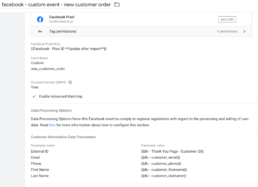How well are your targeting filters working on your Facebook ads? It can be quite hard to tell from standard pixel data what types of customers are seeing and purchasing from your ads. With iOS changes the ability for Facebook to properly filter out known customers has also declined. Ultimately, your older existing customer filters may not be working as well as you think. This means that your customer acquisition campaigns are not performing as well as you think.
Luckily if you are a Shopify customer you can easily send your Facebook pixel additional data context that will allow you to get a more granular view of performance. This can be especially helpful with “black box” campaign types like Advantage+ / ASC. In order to track customer types in platform you just need a simple Shopify script and Google Tag Manager with an imported template. Here is my guide to Facebook pixel new vs returning customer tracking.
Shopify Checkout Additional Script
First add the following script to your checkout additional scripts in Shopify. The script will push some simple customer data into the dataLayer to send to your pixel. Make sure to place the script after your Google Tag Manager Script.
Download the script here:

Google Tag Manager Template
Next download the Google Tag Manager template and upload it to your Tag Manager container. Make sure when you upload it in the admin panel to set it to merge so you don’t overwrite any other items in GTM. Download the GTM template here:
Once you upload the template to GTM all of the variables will be preset for you. All you need to do is update your Facebook pixel ID. Your tag should look like this:

Now publish everything and you’re ready to start viewing the data in ads manager.
Ads Manager Data
Once the events have started sending data to the pixel you can view the performance of these custom events as attributed to your campaigns in ads manager. Here is an example of what the data looks like in ads manager. As you can see, campaigns that were set to exclude an email list of customers weren’t doing a great job of excluding existing customers. Despite the campaign having an existing customer exclusion this ASC campaign was driving almost 50% repeat customers. With some changes in the exclusion parameters it now drives 87% new customers with only 14% coming from existing customer profiles.
ASC New vs Repeat

As a note, this method only uses the web based pixel so if you are using a conversions API implementation you won’t see the new customer + repeat customer orders total add up to the campaigns total attributed purchases. This method won’t capture the additional sales attributed purely through CAPI. Use the ratio between new vs returning customers directionally in this case.
If you have any questions shoot me an email at andrew@amjones.co
or message me on linkedin at https://www.linkedin.com/in/amj45/
Thanks for checking out my guide for facebook pixel new vs returning customer tracking!

Great article. I just started collecting new vs return customer info for both dtc and b2b traffic in Google ads. Can’t wait to read more!
Hello Andrew,
its a great and very helpful Article. as a students i keep on learning and this resources if very help and Free!. 🙂